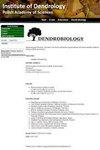观赏棉属植物控制条件下种子休眠的解除。
IF 1.8
4区 农林科学
Q2 FORESTRY
引用次数: 0
摘要
许多树木和灌木的种子需要特定的环境条件才能发芽。在棉花属中,种子通常在地下休眠1-2年。因此,需要了解在受控条件下打破种子休眠的方法。在不同的分层温度和不同的化学划伤条件下,试验了不同温度的分层和化学划伤,以打破金丝桃、水平金丝桃和湖北金丝桃的深双种子休眠。水果是在10月采摘的,那时它们已经完全成熟了。从果实中提取的种子在室温下风干,水分含量约为10%。新鲜和风干种子在不同的交变温度下经历了不同的冷分层或暖冷分层。在浓硫酸中浸泡后,再进行温热分层处理。当出现1-3毫米长的胚根时,即为种子发芽。分层后(约5%种子发芽率),检测种子萌发和出芽情况。在20°/30°C条件下分层12-16周(16/8小时)最有效地打破了风干金针菇和横纹金针菇种子的休眠,其次是在3°C条件下分层15-18周。在浓硫酸中刻蚀3小时,然后在20°/30°C(4周)和3°C(18周)下进行冷热分层,3°/20°C(16/8小时)下hupehensis种子的发芽率最高(48%)。在本实验中,我们证明了在控制条件下,分层或分层与割伤相结合的方法可以打破棉花属植物的生理和物理休眠。本文章由计算机程序翻译,如有差异,请以英文原文为准。
Seed dormancy breaking under controlled conditions in ornamental Cotoneaster spp.
Seeds of numerous trees and shrubs require specific environmental conditions to initiate germination. In the genus Cotoneaster, seeds often remain dormant in the ground for 1–2 years. Therefore, knowledge of the method of breaking seed dormancy under controlled conditions is needed. Various temperatures of stratification and chemical scarification were tested in this work to break deep double seed dormancy under controlled conditions in C. divaricatus, C. horizontalis and C. hupehensis. Fruits were collected in October, when they were fully ripe. The seeds extracted from the fruits were air-dried at room temperature to a moisture content of approximately 10%. Fresh and air-dried seeds were subjected to different variants of cold stratification or warm-cold stratification with different alternating temperatures. The hard seeds of C. hupehensis were also scarified in concentrated sulfuric acid, followed by warm stratification. A seed was counted as germinated when a 1–3 mm long radicle appeared. After stratification (ca. 5% seed germination), seeds were tested for germination and emergence. The dormancy of air-dried C. divaricatus and C. horizontalis seeds was broken most effectively by stratification for 12–16 weeks at 20°/30°C (16/8 hours), followed by 15–18 weeks at 3°C. Scarification in concentrated sulfuric acid for 3 hours followed by warmcold stratification at 20°/30°C (4 weeks) and 3°C (18 weeks) resulted in the highest germination (48%) of C. hupehensis seeds at 3°/20°C (16/8 hours). In our experiment, we demonstrated that the physiological and physical dormancy of Cotoneaster species can be broken under controlled conditions with stratification or stratification combined with scarification methods.
求助全文
通过发布文献求助,成功后即可免费获取论文全文。
去求助
来源期刊

Dendrobiology
农林科学-林学
CiteScore
2.20
自引率
11.10%
发文量
17
审稿时长
>12 weeks
期刊介绍:
Dendrobiology publishes original research articles and review articles related to the biology of trees and shrubs.
 求助内容:
求助内容: 应助结果提醒方式:
应助结果提醒方式:


